
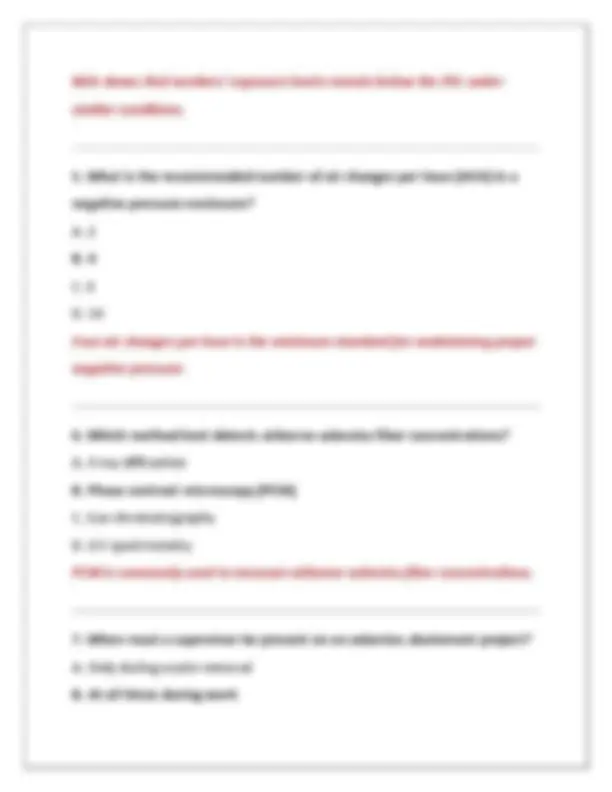
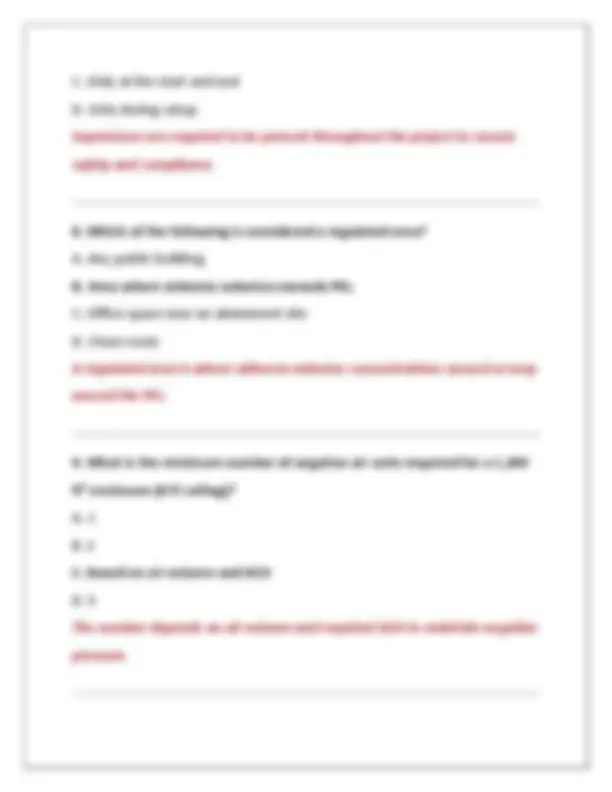
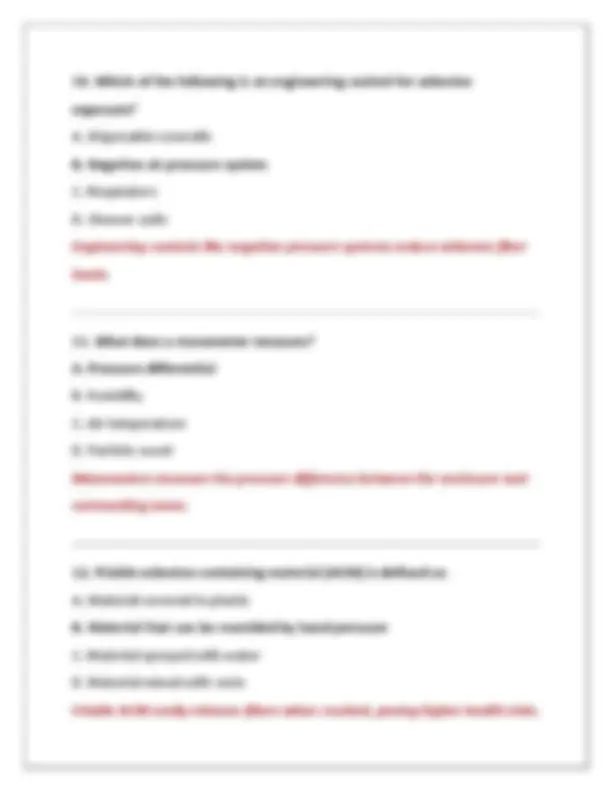
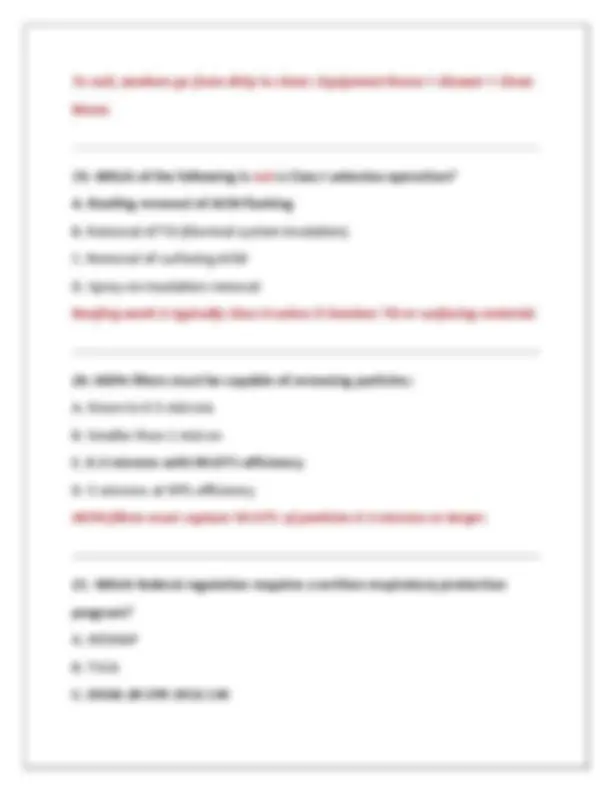
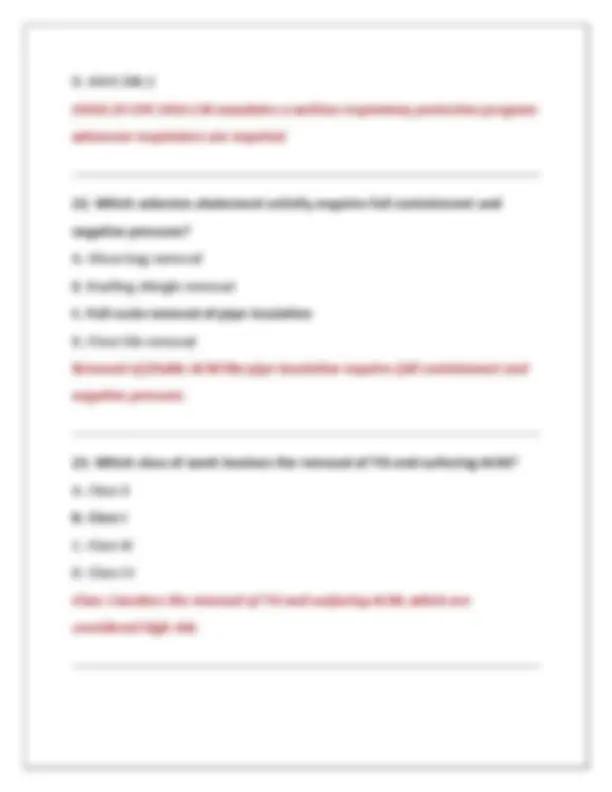
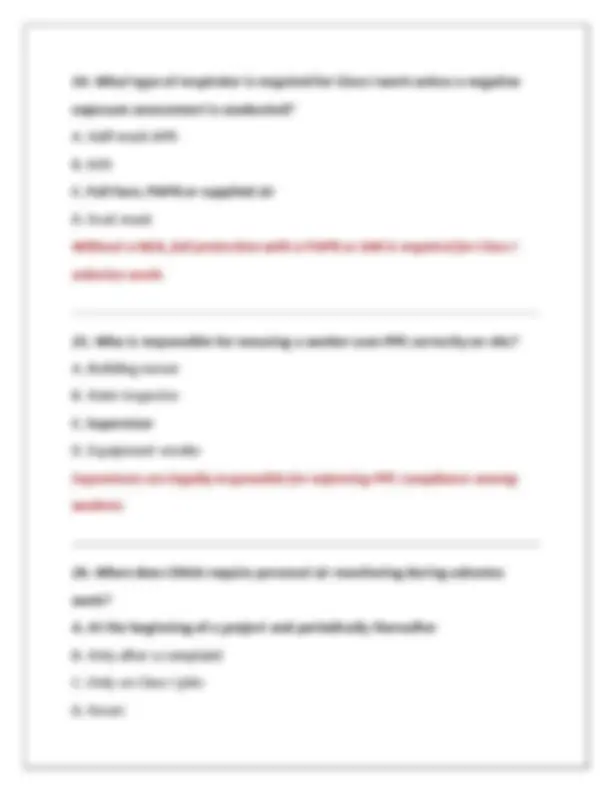
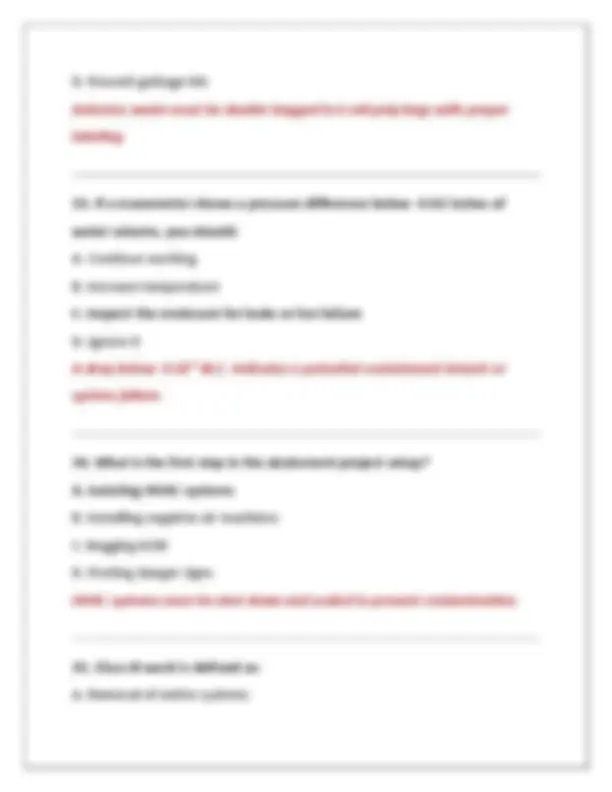
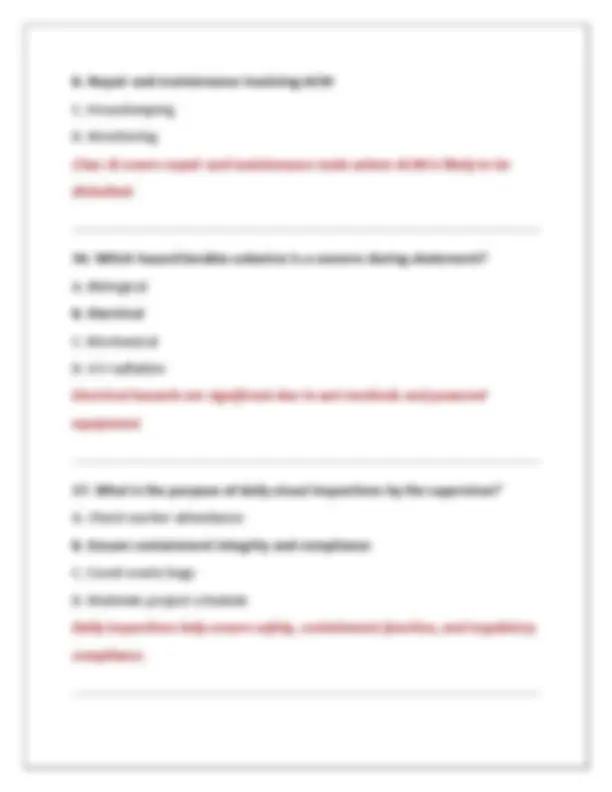
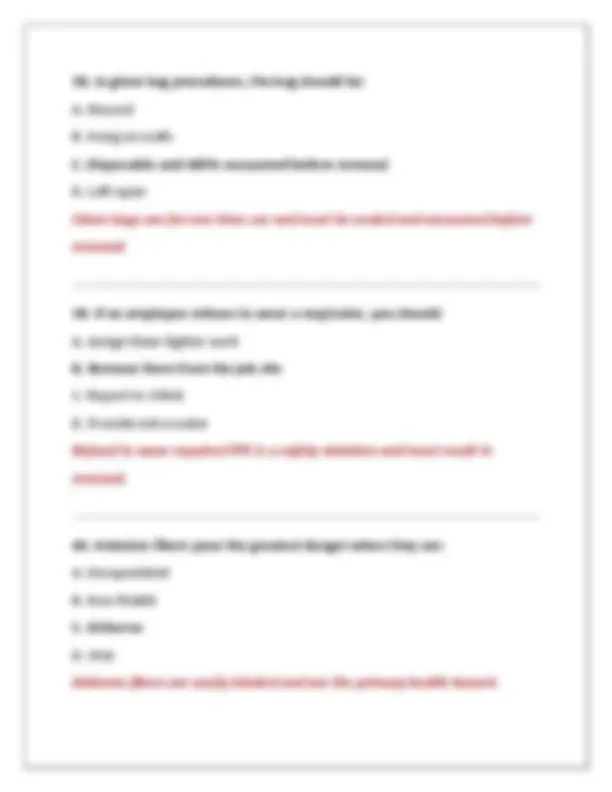
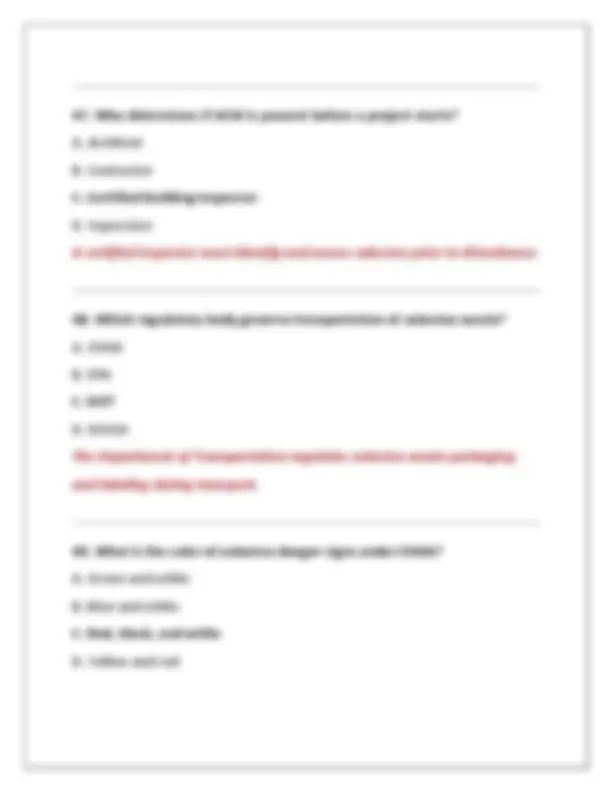
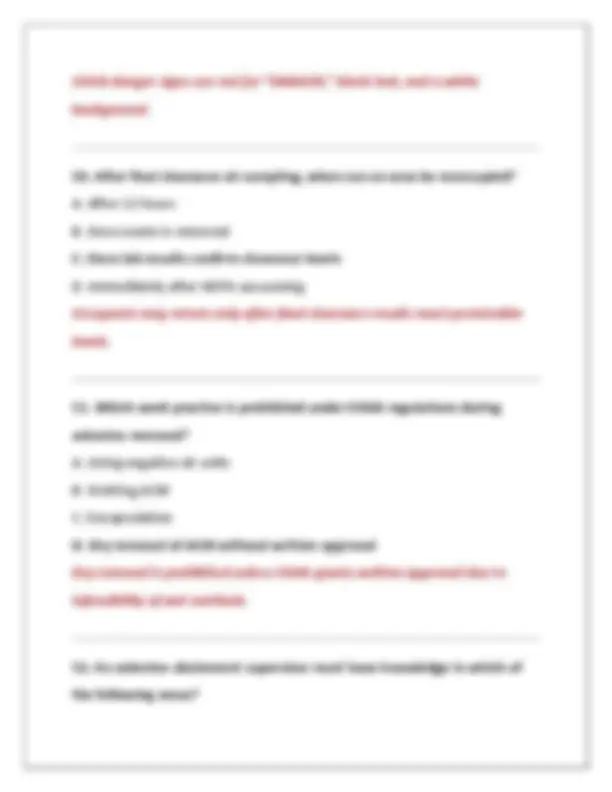
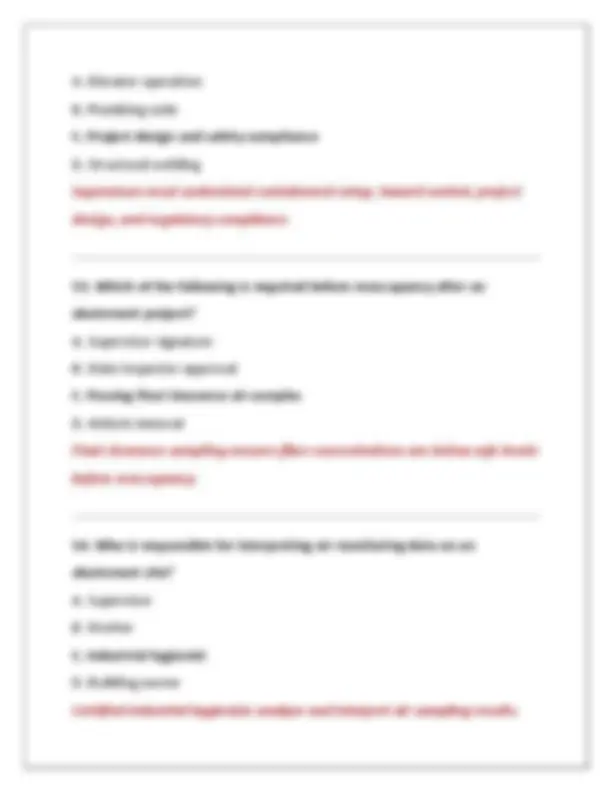
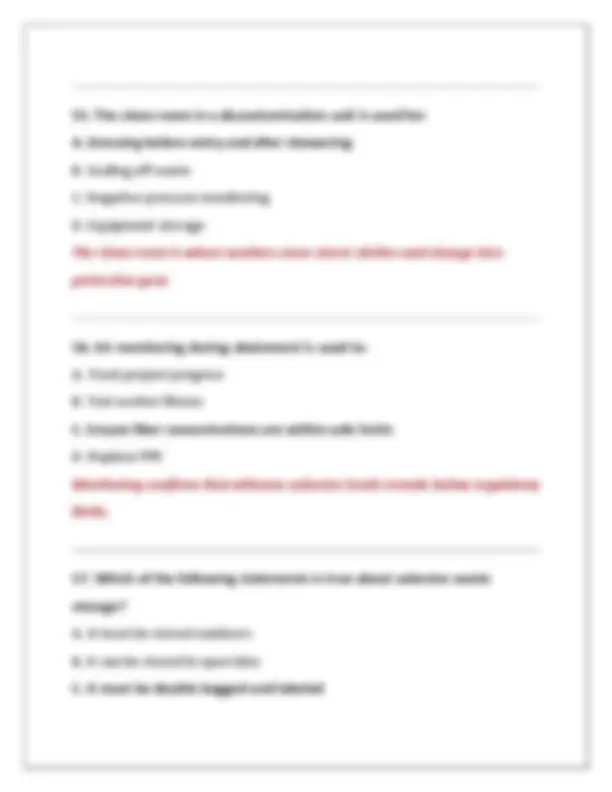
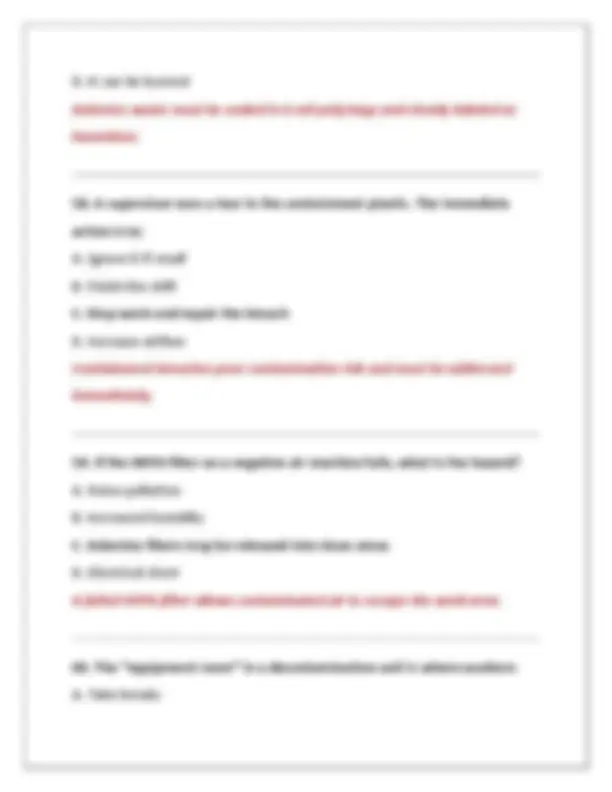
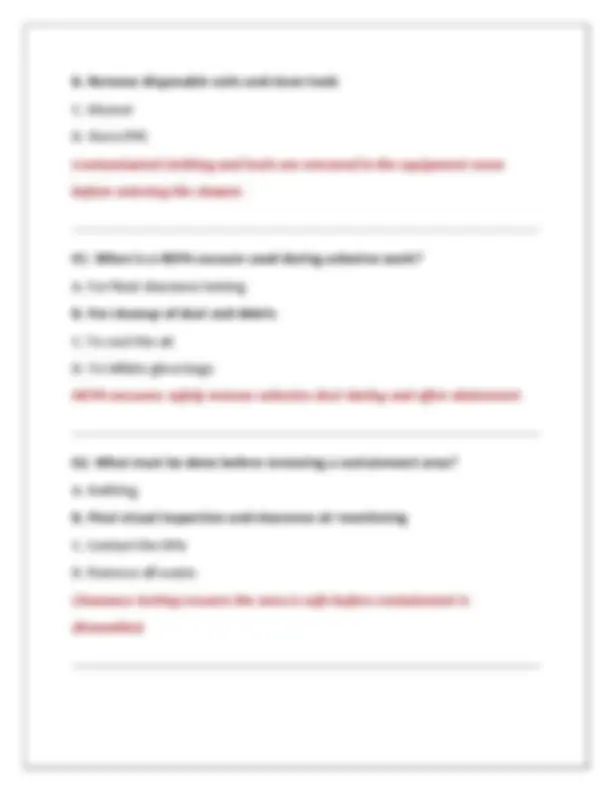
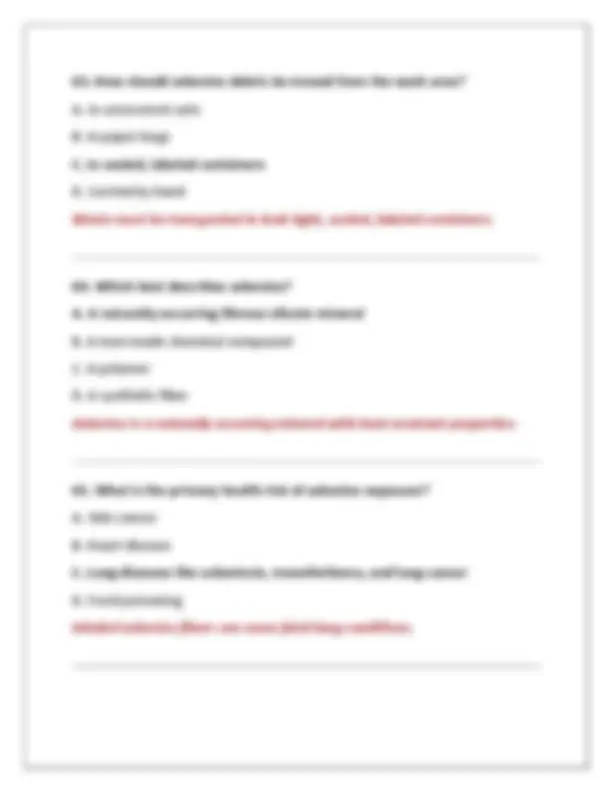
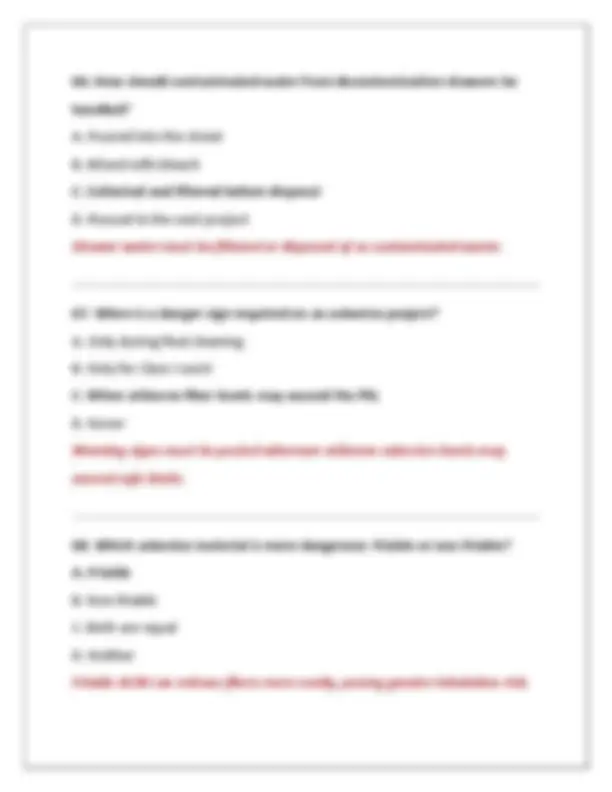
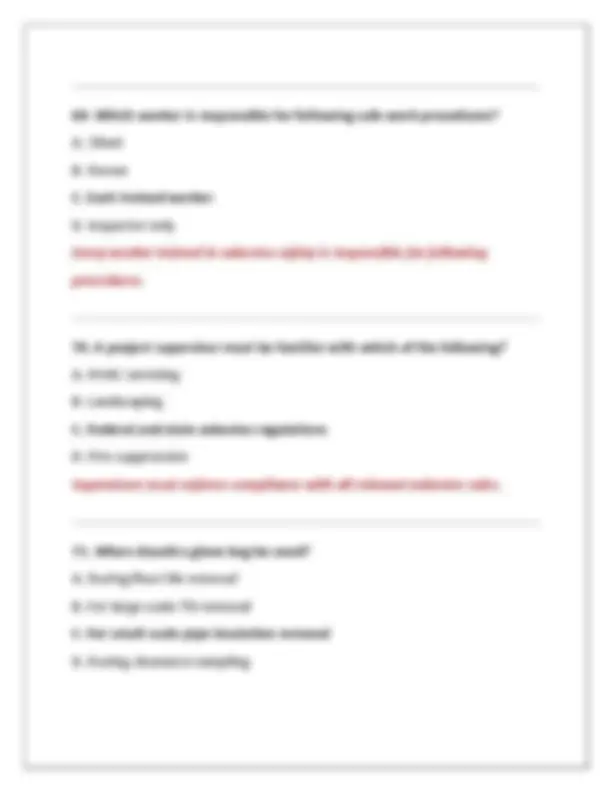
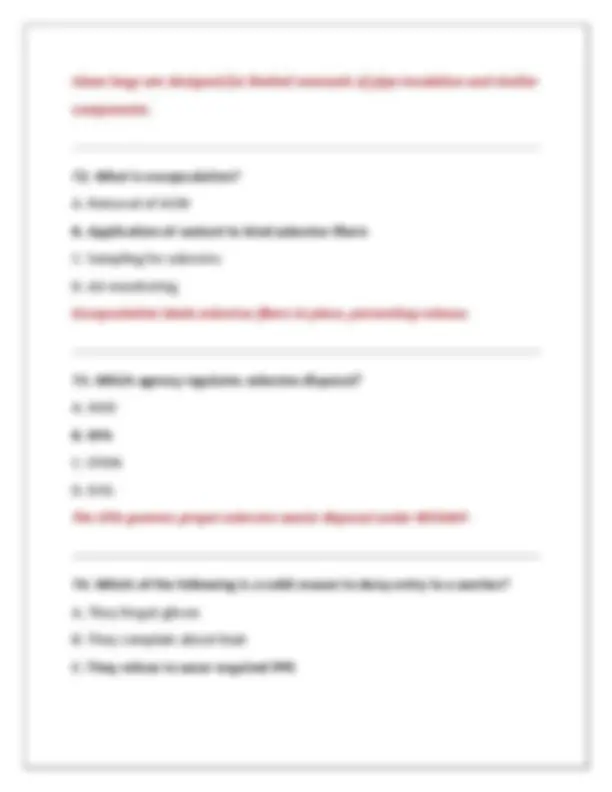
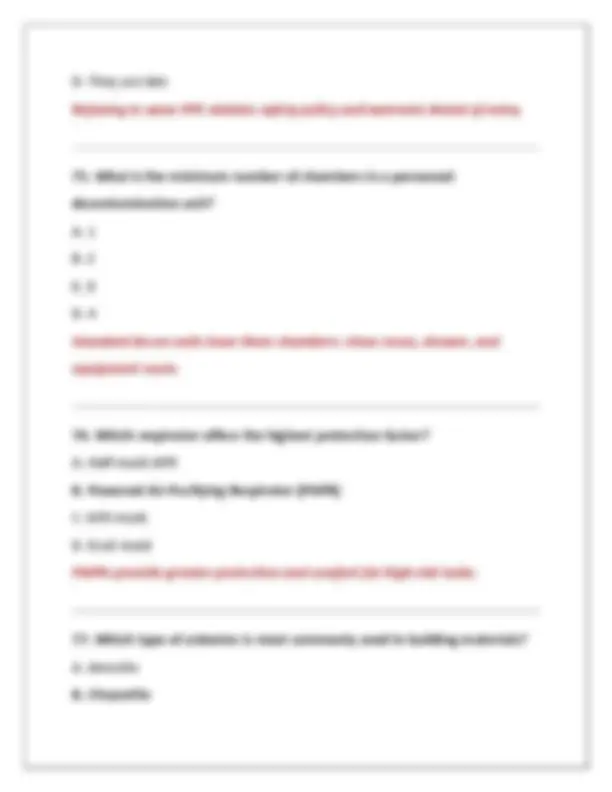
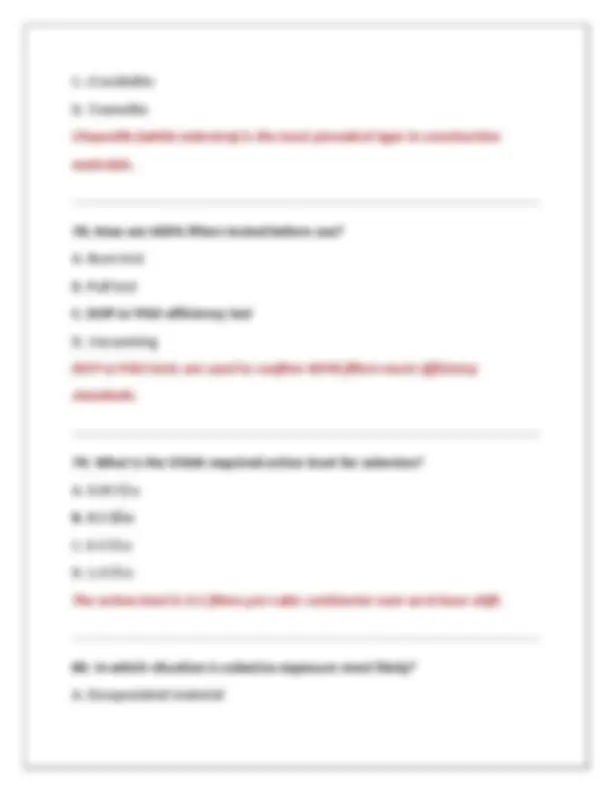
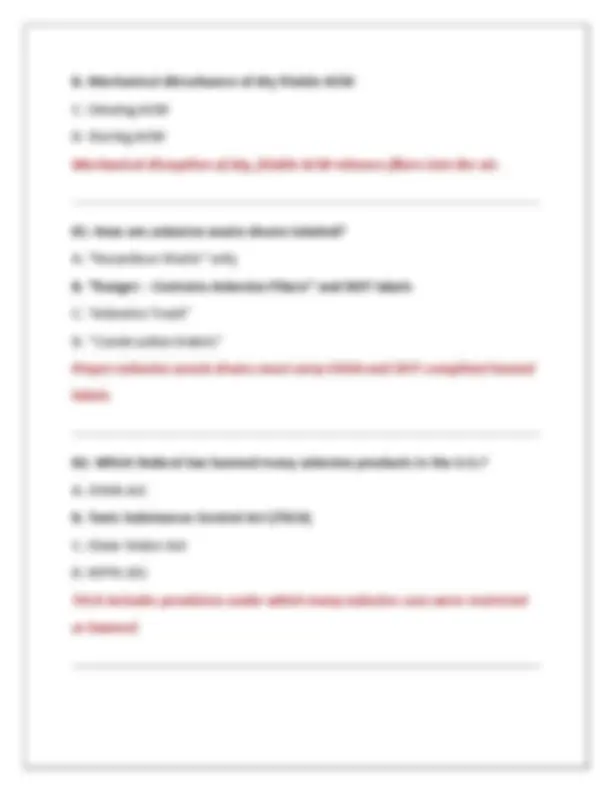
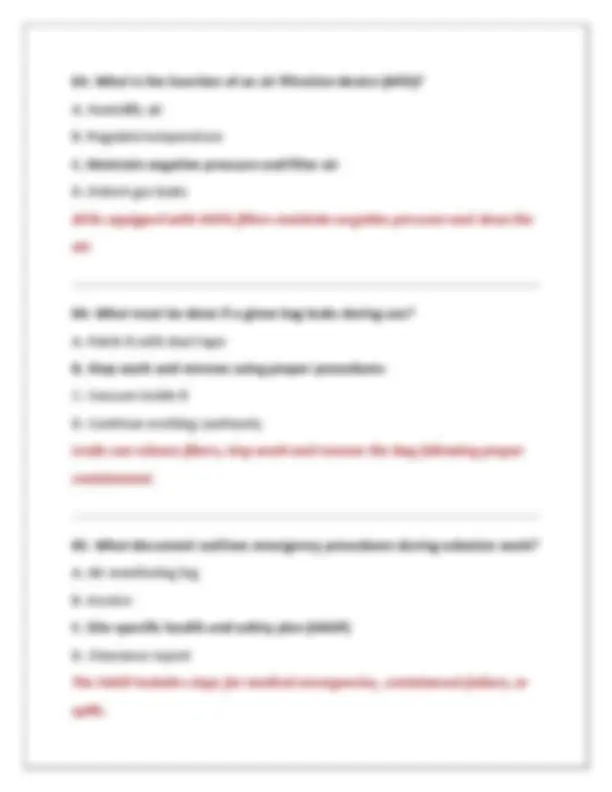



Study with the several resources on Docsity

Earn points by helping other students or get them with a premium plan


Prepare for your exams
Study with the several resources on Docsity

Earn points to download
Earn points by helping other students or get them with a premium plan
Community
Ask the community for help and clear up your study doubts
Discover the best universities in your country according to Docsity users
Free resources
Download our free guides on studying techniques, anxiety management strategies, and thesis advice from Docsity tutors
ASBESTOS SUPERVISOR CERTIFICATION EXAM 2 QUESTIONS AND CORRECT ANSWERS (VERIFIED ANSWERS) PLUS RATIONALES 2025 Q&A | INSTANT DOWNLOAD PDF
Typology: Exams
1 / 32

This page cannot be seen from the preview
Don't miss anything!

























1. What regulation outlines training requirements for asbestos abatement supervisors? A. OSHA 1910. B. EPA Model Accreditation Plan (MAP) C. NIOSH 7400 D. ANSI Z9. The EPA MAP mandates training for asbestos professionals including supervisors, ensuring standardization across states.
2. Which agency enforces worker protection standards at asbestos job sites? A. EPA B. OSHA C. HUD D. DOT OSHA is responsible for enforcing worker safety laws including those related to asbestos exposure. 3. The permissible exposure limit (PEL) for asbestos over an 8-hour TWA is: A. 0.1 ppm B. 1.0 ppm C. 0.1 fibers/cc D. 0.01 fibers/cc OSHA's PEL for asbestos is 0.1 fibers per cubic centimeter of air over 8 hours. 4. Negative exposure assessment (NEA) is used to: A. Eliminate the need for PPE B. Demonstrate employee exposure is below PEL C. Approve project designs D. Replace personal air monitoring
C. Only at the start and end D. Only during setup Supervisors are required to be present throughout the project to ensure safety and compliance.
8. Which of the following is considered a regulated area? A. Any public building B. Area where airborne asbestos exceeds PEL C. Office space near an abatement site D. Clean room A regulated area is where airborne asbestos concentrations exceed or may exceed the PEL. 9. What is the minimum number of negative air units required for a 1, ft² enclosure (8 ft ceiling)? A. 1 B. 2 C. Based on air volume and ACH D. 5 The number depends on air volume and required ACH to maintain negative pressure.
10. Which of the following is an engineering control for asbestos exposure? A. Disposable coveralls B. Negative air pressure system C. Respirators D. Shower units Engineering controls like negative pressure systems reduce airborne fiber levels. 11. What does a manometer measure? A. Pressure differential B. Humidity C. Air temperature D. Particle count Manometers measure the pressure difference between the enclosure and surrounding areas. 12. Friable asbestos-containing material (ACM) is defined as: A. Material covered in plastic B. Material that can be crumbled by hand pressure C. Material sprayed with water D. Material mixed with resin Friable ACM easily releases fibers when crushed, posing higher health risks.
16. Which document outlines proper waste handling of asbestos materials? A. OSHA 1926 B. NESHAP 40 CFR 61, Subpart M C. ANSI A D. HUD Rule The EPA's NESHAP regulations cover asbestos waste handling and disposal. 17. Which type of glove is best for handling wet asbestos? A. Latex gloves B. Cotton gloves C. Nitrile or neoprene gloves D. Leather gloves Nitrile or neoprene gloves resist water and chemicals, offering protection when handling wet ACM. 18. What is the proper sequence for decontamination unit entry/exit? A. Clean room > Shower > Equipment room B. Equipment room > Shower > Clean room C. Shower > Equipment room > Clean room D. Shower > Clean room > Equipment room
To exit, workers go from dirty to clean: Equipment Room > Shower > Clean Room.
19. Which of the following is not a Class I asbestos operation? A. Roofing removal of ACM flashing B. Removal of TSI (thermal system insulation) C. Removal of surfacing ACM D. Spray-on insulation removal Roofing work is typically Class II unless it involves TSI or surfacing material. 20. HEPA filters must be capable of removing particles: A. Down to 0.5 microns B. Smaller than 1 micron C. 0.3 microns with 99.97% efficiency D. 5 microns at 95% efficiency HEPA filters must capture 99.97% of particles 0.3 microns or larger. 21. Which federal regulation requires a written respiratory protection program? A. NESHAP B. TSCA C. OSHA 29 CFR 1910.
24. What type of respirator is required for Class I work unless a negative exposure assessment is conducted? A. Half-mask APR B. N C. Full-face, PAPR or supplied air D. Dust mask Without a NEA, full protection with a PAPR or SAR is required for Class I asbestos work. 25. Who is responsible for ensuring a worker uses PPE correctly on site? A. Building owner B. State inspector C. Supervisor D. Equipment vendor Supervisors are legally responsible for enforcing PPE compliance among workers. 26. When does OSHA require personal air monitoring during asbestos work? A. At the beginning of a project and periodically thereafter B. Only after a complaint C. Only on Class I jobs D. Never
OSHA mandates initial monitoring unless objective data or a NEA is available.
27. The function of a decontamination unit is to: A. Store tools and materials B. Prevent spread of asbestos fibers to clean areas C. Maintain temperature D. House air monitoring devices The decon unit limits contamination by providing a clean path in and out of the enclosure. 28. Who approves a variance from OSHA asbestos standards? A. OSHA B. EPA C. NIOSH D. Local health department Only OSHA has the authority to issue variances to its own standards. 29. Wet methods are used during removal because they: A. Clean the surface B. Suppress fiber release C. Eliminate the need for respirators
D. Reused garbage bin Asbestos waste must be double-bagged in 6-mil poly bags with proper labeling.
33. If a manometer shows a pressure difference below - 0.02 inches of water column, you should: A. Continue working B. Increase temperature C. Inspect the enclosure for leaks or fan failure D. Ignore it A drop below - 0.02" W.C. indicates a potential containment breach or system failure. 34. What is the first step in the abatement project setup? A. Isolating HVAC systems B. Installing negative air machines C. Bagging ACM D. Posting danger signs HVAC systems must be shut down and sealed to prevent contamination. 35. Class III work is defined as: A. Removal of entire systems
B. Repair and maintenance involving ACM C. Housekeeping D. Monitoring Class III covers repair and maintenance tasks where ACM is likely to be disturbed.
36. Which hazard besides asbestos is a concern during abatement? A. Biological B. Electrical C. Mechanical D. UV radiation Electrical hazards are significant due to wet methods and powered equipment. 37. What is the purpose of daily visual inspections by the supervisor? A. Check worker attendance B. Ensure containment integrity and compliance C. Count waste bags D. Maintain project schedule Daily inspections help ensure safety, containment function, and regulatory compliance.
41. What component ensures filtered air in a negative air machine? A. Standard furnace filter B. HEPA filter C. Water filter D. Carbon filter HEPA filters remove airborne asbestos fibers in containment environments. 42. What label is required on asbestos waste bags? A. “Caution” B. “DANGER: Contains Asbestos Fibers” C. “Handle with Care” D. “Hazardous Material Only” Bags must carry the EPA/OSHA warning label identifying asbestos content. 43. For which project would glove bags be inappropriate? A. Short pipe runs B. Valve insulation C. Large-scale boiler insulation removal D. Pipe elbows Glove bags are intended for localized, small-scale abatement tasks only.
44. A supervisor's training must be refreshed: A. Every 5 years B. Annually C. Only once D. Every 3 years Annual refresher training is required by EPA’s MAP and most state regulations. 45. Which of the following is a Class IV task? A. Removing ACM from walls B. Cleaning asbestos-containing dust C. Repairing TSI D. Handling floor tile Class IV covers cleaning tasks where dust or debris from ACM is present. 46. If a negative pressure enclosure collapses, your first action should be: A. Call the client B. Continue work C. Evacuate and stop all work D. Increase air pressure A collapse can lead to exposure and contamination. Immediate evacuation is required.
OSHA danger signs use red for “DANGER,” black text, and a white background.
50. After final clearance air sampling, when can an area be reoccupied? A. After 12 hours B. Once waste is removed C. Once lab results confirm clearance levels D. Immediately after HEPA vacuuming Occupants may return only after final clearance results meet permissible levels. 51. Which work practice is prohibited under OSHA regulations during asbestos removal? A. Using negative air units B. Wetting ACM C. Encapsulation D. Dry removal of ACM without written approval Dry removal is prohibited unless OSHA grants written approval due to infeasibility of wet methods. 52. An asbestos abatement supervisor must have knowledge in which of the following areas?
A. Elevator operation B. Plumbing code C. Project design and safety compliance D. Structural welding Supervisors must understand containment setup, hazard control, project design, and regulatory compliance.
53. Which of the following is required before reoccupancy after an abatement project? A. Supervisor signature B. State inspector approval C. Passing final clearance air samples D. Airlock removal Final clearance sampling ensures fiber concentrations are below safe levels before reoccupancy. 54. Who is responsible for interpreting air monitoring data on an abatement site? A. Supervisor B. Worker C. Industrial hygienist D. Building owner Certified industrial hygienists analyze and interpret air sampling results.